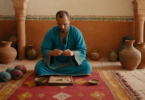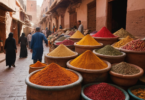Moroccan weddings are an extraordinary celebration that blends centuries-old traditions with vibrant festivities, creating an unforgettable experience for both participants and guests. The Moroccan wedding, characterized by its cultural significance, extravagant displays of luxury, and joyous celebrations, offers a unique insight into the nation’s rich heritage. In this article, we will explore the various elements that make up a Moroccan wedding, from the pre-wedding rituals to the grand celebrations, and help you understand the customs that have been passed down through generations.
The Cultural Significance of Moroccan Weddings
Weddings in Morocco are not merely social events; they are a culmination of family heritage, community bonds, and religious significance. The celebration is deeply rooted in Moroccan culture, where family, hospitality, and tradition play pivotal roles. The wedding is seen as the union of not just two individuals, but two families, and often involves a series of elaborate rituals meant to honor both the couple and their ancestors.
Moroccan weddings are celebrated with great enthusiasm, often lasting several days, depending on the region. The celebration is a communal affair, with family, friends, and even distant acquaintances taking part in the festivities. The event is infused with local customs, traditional music, dancing, and a wealth of delicious food, which all contribute to creating a magical atmosphere.
Pre-Wedding Rituals
The preparation for a Moroccan wedding begins long before the actual ceremony, with a series of traditional rituals that set the stage for the celebrations.
1. The Engagement (Khotba)
The first official step towards marriage in Morocco is the engagement, known as the Khotba. This typically involves a formal meeting between the families of the bride and groom, where the couple’s parents come together to discuss the union. Traditionally, the engagement is an important occasion for both families to agree on the marriage contract and any financial matters, including the Mahr (dowry) that the groom must provide to the bride.
During the Khotba, the groom presents gifts to the bride’s family, and the couple’s future together is discussed. It is common for the bride to wear a traditional dress during this engagement ceremony, symbolizing the union of the two families.
2. The Henna Ceremony (Laylat al-Henna)
One of the most exciting pre-wedding traditions is the Henna ceremony, known as Laylat al-Henna. This is a special event typically held the night before the wedding day, where the bride and close female relatives gather to apply henna tattoos on their hands and feet. Henna is not only considered a symbol of beauty and femininity but also serves as a protective charm to ward off evil spirits and bring good luck to the bride.
The ceremony is filled with music, dancing, and singing, and it’s often a chance for the bride to bond with her female friends and family members. During this occasion, the bride wears a colorful caftan or moroccan djellaba, adding to the festive spirit of the evening.
The Wedding Day: A Grand Affair
Moroccan weddings are known for their grandiosity, and the wedding day itself is marked by a series of elaborate customs and vibrant celebrations. Here is an overview of what you can expect when attending a Moroccan wedding.
1. The Bridal Procession (Zaffa)
The wedding day begins with the Zaffa, the bridal procession, which is a highly anticipated moment in any Moroccan wedding. The bride, often dressed in an intricate, heavily embroidered wedding dress, is accompanied by her family and friends as she makes her way to the ceremony venue. The groom typically awaits her arrival at a separate location.
The Zaffa is a joyous and lively procession, complete with traditional music, drumming, and dancing. The bride may also wear a tiara, symbolizing her new status as a married woman, and she is often carried by her friends and family in a luxurious sedan chair or on a horse-drawn carriage, depending on the region.
2. The Ceremony and Religious Blessings
The actual wedding ceremony in Morocco typically takes place at a mosque or a home, depending on the couple’s preferences. During the ceremony, the Imam (religious leader) recites verses from the Quran and provides a religious blessing for the couple. Marriage in Islam, which is the predominant religion in Morocco, is considered a sacred contract, and the ceremony often involves the signing of the marriage contract.
The groom typically presents the bride with the Mahr (dowry), and the couple’s marriage is solemnized with the mutual consent of both parties. The ceremony is often followed by a feast, where the newlywed couple is celebrated by family and friends.
3. Lavish Reception and Festivities
After the ceremony, the wedding moves into full celebration mode. The reception is a lavish affair, often held at a grand venue, such as a hotel or a private estate, where guests are treated to a feast of traditional Moroccan cuisine. The meal typically includes dishes like couscous, tagine, pastilla, and an array of fresh fruits, nuts, and pastries.
Music and traditional Moroccan dancing are a significant part of the festivities, with live performances from gnawa musicians and folk dancers adding to the energy and excitement of the event. The dance floor is often filled with people of all ages, and it’s not uncommon for guests to engage in the Chaâbi or Raha dances, traditional Moroccan dances that symbolize joy and celebration.
Guests are encouraged to dress in formal attire, and many Moroccan weddings feature elaborate costumes, including caftans for women and djellabas for men. The attire adds a layer of elegance and beauty to the event, further enhancing the festive atmosphere.
4. The Bride’s Several Outfits
A signature element of Moroccan weddings is the bride’s wardrobe. The bride will change into multiple traditional outfits throughout the celebration. Each outfit is carefully chosen to symbolize different stages of the wedding, and often features intricate embroidery, luxurious fabrics, and precious jewels.
The bride may wear a traditional white wedding dress during the ceremony, but will often switch to other dresses, such as the caftan, a beautifully adorned gown, for the reception. Each new outfit is celebrated by the guests, who often shower the bride with gifts and well-wishes.
Post-Wedding Traditions
After the wedding celebrations, there are several post-wedding rituals that take place. In some regions of Morocco, the bride and groom will spend time in seclusion for a period of rest and reflection. This is followed by visits from family and friends who come to celebrate the couple’s new life together.
Additionally, the newlyweds may receive gifts from family members and extended relatives, including gold jewelry, clothing, and household items. These gifts are a way to show support for the new couple as they begin their married life.
Conclusion
Attending a Moroccan wedding is an immersive experience that allows you to witness the deep-rooted cultural traditions of the country. From the elaborate rituals and vibrant celebrations to the delicious food and beautiful attire, a Moroccan wedding is a rich cultural experience that offers a window into the heart of Moroccan society. Whether you are a guest or a participant, you are sure to be enchanted by the warmth, hospitality, and joyful spirit that define this extraordinary celebration of love.







